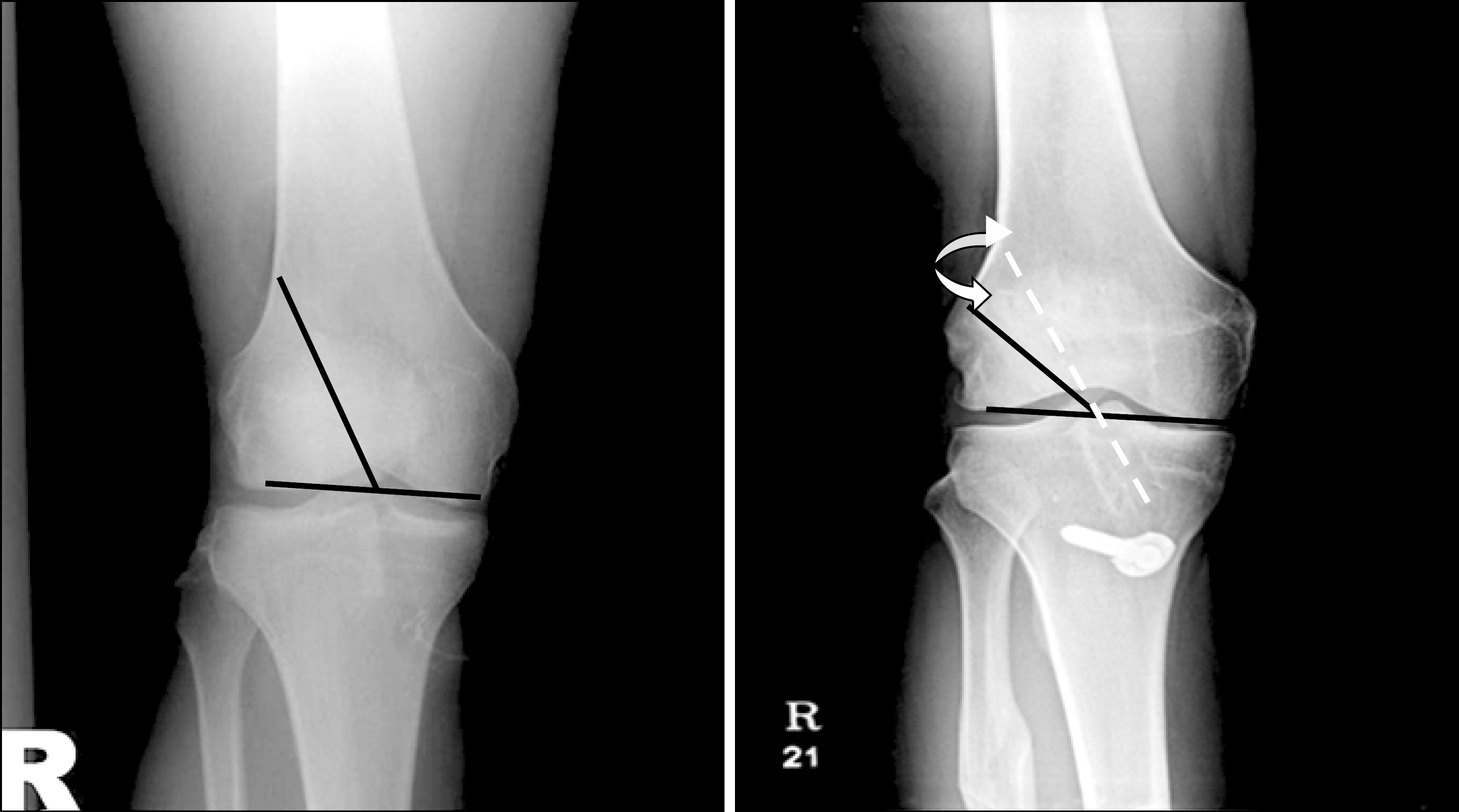Korean J Sports Med.
2011 Dec;29(2):93-98. 10.5763/kjsm.2011.29.2.93.
Revision Anterior Cruciate Ligament Reconstruction Using Two Anteromedial Portal Technique
- Affiliations
-
- 1Department of Orthopedic Surgery, Inha Hospital, Inha University Medical College, Incheon, Korea. m9kim@inha.ac.kr
- KMID: 1987188
- DOI: http://doi.org/10.5763/kjsm.2011.29.2.93
Abstract
- There are numerous reasons for the failure of anterior cruciate ligament (ACL) reconstruction. Among them, surgical technical failure and wrong femoral tunnel location are the most common. The authors focused on the results of ACL revision using two anteromedial portals. Sixteen patients were selected with two anteromedial portals that were designed to decrease the femoral tunnel slope in sagittal plane. Clinical analysis was carried out based on Lysholm score, Tegner score and International Knee Documentation Committee (IKDC). For anterior stability test, Lachman test, KT-2000 arthrometer were used. pivot shift test was measured for rotatory stability test. Preoperative Lachman test and pivot shift test showed positive finding in all cases, however, postoperative Lachman with 10 cases (62.5%) and pivot shift test with 10 cases (62.5%) were negative. The difference of anterior displacement with the non-affected side using KT 2000 arthrometer showed 6.57 mm (range: 4.0-12.0 mm) preoperatively and 2.20 mm (range: 1.0-4.0 mm) postoperatively on average. Score of Tegner and Lysholm improved from 4.86 (range: 2.0-7.0), 46.14 (range: 33-52) preoperatively, to postoperative score of 8.14 (range: 7.0-9.0), 83.43 (range: 74-89) at the final follow up. IKDC result also showed improvement. ACL reconstruction method using two anteromedial tunnels that is desgined to decrease femoral tunnel slope at sagittal plane is an effective technigue for revision surgery after initial ACL reconstruction failure. This technigue allows superior femoral tunnel selection, firm fixation of grafts and also shows excellent clinical results with stability.
MeSH Terms
Figure
Reference
-
References
1. Bin SI, Chung ER. Arthroscopic revision anterior cruciate ligament reconstruction: report of 5 cases J Korean Orthop Assoc. 1995; 30:1767–73.2. Uribe JW, Hechtman KS, Zvijac JE, Tjin-A-Tsoi EW. Revision anterior cruciate ligament surgery: experience from Miami. Clin Orthop Relat Res. 1996; 325:91–9.
Article3. Johnson DL, Fu FH. Anterior cruciate ligament reconstruction: why do failures occur? Instr Course Lect. 1995; 44:391–406.4. Johnson DL, Swenson TM, Irrgang JJ, Fu FH, Harner CD. Revision anterior cruciate ligament surgery: experience from Pittsburgh. Clin Orthop Relat Res. 1996; 325:100–9.
Article5. Alm A, Gillquist J, Strömberg B. The medial third of the patellar ligament in reconstruction of the anterior cruciate ligament. A clinical and histologic study by means of arthro-scopy or arthrotomy. Acta Chir Scand Suppl. 1974; 445:5–14.6. Carson EW, Simonian PT, Wickiewicz TL, Warren RF. Revision anterior cruciate ligament reconstruction. Instr Course Lect. 1998; 47:361–8.7. Yamamoto Y, Hsu WH, Woo SL, Van Scyoc AH, Takakura Y, Debski RE. Knee stability and graft function after anterior cruciate ligament reconstruction: a comparison of a lateral and an anatomical femoral tunnel placement. Am J Sports Med. 2004; 32:1825–32.8. Spindler KP. The Multicenter ACL Revision Study (MARS): a prospective longitudinal cohort to define outcomes and independent predictors of outcomes for revision anterior cruciate ligament reconstruction. J Knee Surg. 2007; 20:303–7.
Article9. Fox JA, Pierce M, Bojchuk J, Hayden J, Bush-Joseph CA, Bach BR Jr. Revision anterior cruciate ligament reconstruction with nonirradiated fresh-frozen patellar tendon allograft. Arthroscopy. 2004; 20:787–94.
Article10. Bach BR Jr, Warren RF, Wickiewicz TL. The pivot shift phenomenon: results and description of a modified clinical test for anterior cruciate ligament insufficiency. Am J Sports Med. 1988; 16:571–6.
Article11. Wirth CJ, Kohn D. Revision anterior cruciate ligament sur-gery: experience from Germany. Clin Orthop Relat Res. 1996; 325:110–5.
Article12. Carson EW, Anisko EM, Restrepo C, Panariello RA, O'Brien SJ, Warren RF. Revision anterior cruciate ligament reconstruction: etiology of failures and clinical results. J Knee Surg. 2004; 17:127–32.13. Safran MR, Harner CD. Technical considerations of revision anterior cruciate ligament surgery. Clin Orthop Relat Res. 1996; 325:50–64.
Article14. Harner CD, Poehling GG. Double bundle or double trouble? Arthroscopy. 2004; 20:1013–4.
Article
- Full Text Links
- Actions
-
Cited
- CITED
-
- Close
- Share
- Similar articles
-
- Femoral Tunnel Drilling Techniques in Anterior Cruciate Ligament Reconstruction
- Single Bundle Anterior Cruciate Ligament Reconstruction
- Preparation of the Femoral Tunnel through Anteromedial Portal during Arthroscopic Single Incision Anterior Cruciate Ligament Reconstruction
- Revision Anterior Cruciate Ligament Reconstruction
- Anatomic Single Bundle Anterior Cruciate Ligament Reconstruction by Low Accessory Anteromedial Portal Technique: An In Vivo 3D CT Study





